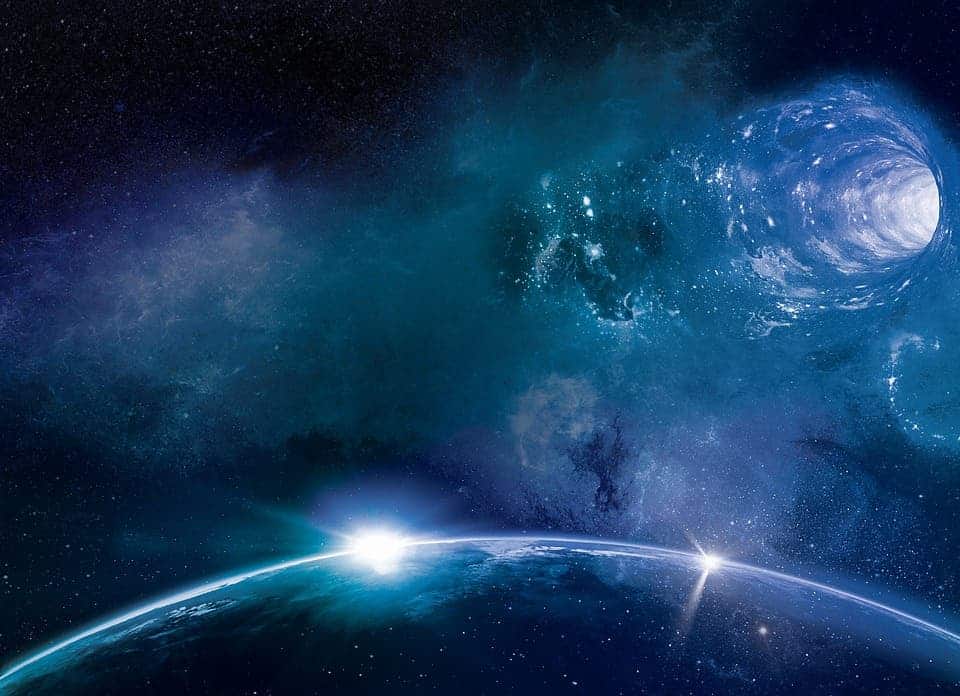
In the move Interstellar, former NASA pilot Joseph Cooper (Matthew McConaughey) is sent hurtling through time and space via a wormhole in order to save humanity. Essentially, humans have screwed up this planet to the extent that in order to survive, we all have to move to a less-screwed-up planet. The quickest way to this new future home is through a wormhole near Saturn. This opening is the entrance to a distant galaxy located near a black hole named Gargantua. And, of course, if anyone can do it, it’s the bad-ass McConaughey.
Wormholes have always been the fascinating stuff of sci-fi, because come on, intertwining dimensions by bending space and time is pretty cool. Unfortunately, they’ve never been proven to actually exist. Luckily, however, that hasn’t put off scientists from trying. Now a new study out of the University of Buffalo (UB) has attempted to take a look at what they would look like if they were real.
Obviously, the first place you would look for a wormhole would be a black hole or a binary black hole system, which involves two black holes circling one another. Theoretically, the insane amount of gravity would pull them together and create a tunnel.
For their study, the researchers focused on Sagittarius A*, an object that’s thought to be a supermassive black hole at the heart of the Milky Way galaxy. While there’s no evidence of a wormhole there, it’s a good place to look for one because wormholes are expected to require extreme gravitational conditions, such as those present at supermassive black holes.
Black holes are massive pits of gravity that will bend space-time due to their incredibly dense centers, or singularities. When a massive star dies, it collapses inward, and as it does so, the star explodes into a supernova — a catastrophic expulsion of its outer material. This dying star will continue to collapse until it becomes either a neutron star or a singularity — something consisting of zero volume and infinite density. This seemingly impossible contradiction is what causes a black hole to form.
The UB scientists believed that if a wormhole does exist at Sagittarius A, nearby stars would be influenced by the gravity of stars at the other end of the passage. As a result, it would be possible to detect the presence of a wormhole by searching for small deviations in the expected orbit of stars near Sagittarius A.
“If you have two stars, one on each side of the wormhole, the star on our side should feel the gravitational influence of the star that’s on the other side. The gravitational flux will go through the wormhole,” says Dejan Stojkovic, PhD, cosmologist and professor of physics in UB’s College of Arts and Sciences. “So if you map the expected orbit of a star around Sagittarius A*, you should see deviations from that orbit if there is a wormhole there with a star on the other side.”
The research, which was published in Physical Review D, focuses on how scientists could hunt for a wormhole by looking for perturbations in the path of S2, a star that astronomers have observed orbiting Sagittarius A*.
While current surveying techniques are not yet precise enough to reveal the presence of a wormhole, Stojkovic says that collecting data on S2 over a longer period of time or developing techniques to track its movement more precisely would make such a determination possible. These advancements aren’t too far off, he says, and could happen within one or two decades.
The good doctor cautions, however, that although this new method might be used to detect a wormhole if one is there, it will not strictly prove that a wormhole is present.
“When we reach the precision needed in our observations, we may be able to say that a wormhole is the most likely explanation if we detect perturbations in the orbit of S2,” he says. “But we cannot say that, ‘Yes, this is definitely a wormhole.’ There could be some other explanation, something else on our side perturbing the motion of this star.”
Wormholes were originally conceived in 1916 by Ludwig Flamm. The Austrian physicist was reviewing another physicist’s solution to the equations in Albert Einstein’s theory of general relativity when he believed another solution might, in fact, be possible. His “white hole” was a theoretical time reversal of a black hole. Entrances to both black and white holes could be connected by a space-time conduit.
Though, if we ever do find one, it probably won’t be the one that science fiction has shown us.
“Even if a wormhole is traversable, people and spaceships most likely aren’t going to be passing through,” says Stojkovic . “Realistically, you would need a source of negative energy to keep the wormhole open, and we don’t know how to do that. To create a huge wormhole that’s stable, you need some magic.”









